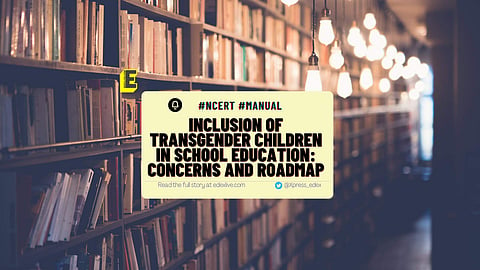

The National Council of Educational Research and Training (NCERT) has released a draft manual titled "Integrating Transgender Concerns in Schooling Processes" for integrating the third gender into schools. The manual was prepared by a 16-member committee headed by Jyotsna Tiwari, head of NCERT's Department of Gender Studies. Recommendations in the draft include gender-neutral uniforms, a transgender-inclusive curriculum, safe restroom facilities, and measures to prevent gender-based violence, as per a PTI report.
According to the draft manual, "Some of the students, specially from Grade VI onward, have a preference for clothes, particularly school uniform. They do not feel comfortable in a particular dress. Schools can introduce gender-neutral uniforms which are comfortable, climate appropriate, fit and do not conform to a particular gender." Additionally, the panel suggested that these uniforms could be designed by design institutes.
Sharing more in this regard, it said, "Many schools have introduced pants and shirts that can suit any gender and they are comfortable for all school activities. Reinforcement of gender binaries in school structures, in terms of uniforms, use of toilets, participation in sports and extra-curricular activities, bullying and harassment for simply choosing to express themselves as opposed to social norms, are some of the glaring concerns raised by transgender persons when it comes to the barrier in their education," it added.
The panel proposed that educators should identify opportunities to integrate gender, particularly transgender concerns, into their pedagogy and textbook content wherever they find gaps in existing materials. In doing so, the manual suggests that "Such practices should be shared with fellow teachers (subject or stage-specific) to collectively evolve best practices which are context specific. Issues of masculinity, equality and empowerment must be addressed through a careful choice of themes in our textbooks as well as through other pedagogies such as role play, debates, creative writing, development of short films, etc."
"If students are noticed to be gender non-conforming or emerge as transgender at this stage, help them to form healthy, supportive alliances with peers and generate a gender-sensitive school environment so that such a student feels supported. Health educators should be gender sensitive and use gender-inclusive practices while educating on puberty, sex education and health education," the manual added.
Adding more, it said, "These interactions could be with family members, school peers or society at large. It might include experiences of rejection within the process of seeking identification of their gender identity or asking to be called by the name they selected for affirming their gender identity. These are everyday yet profound events of experiencing violence by transgender persons." Further, "It needs to be noted that 'homophobic and transphobic' violence is also associated with poorer than average physical and mental health. The adverse effects on young people's mental and psychological health include increased risk of anxiety, fear, stress, loss of confidence, low self-esteem, loneliness, self-harm, depression and suicide," it added.
Consequently, elaborating on the need for a "transgender inclusive" environment in schools, the manual has noted that the behaviours and expressions exist within the gender binary, they are seen as "normal" and are treated as acceptable. "In the case of children who do not conform to such binary roles, expressions, behaviour, which typically associate with their assigned sex and thereby gender; they are made to feel as abnormal."
In this regard, it said, "This affects the childhood and adolescence of many transgender children due to incidences at school since these cases mostly go unreported due to the stigma attached. It often leads to discontinuation of their formal education or a drastic decline in their academic performances," it said.
Further, the panel stressed that while introducing a transgender-inclusive curriculum, it is best to do so collectively as a school community, led by the administrative and school leaders. Additionally, it is also recommended that the decisions in this regard be communicated through gender-specific professional development for educators and community members at the start of each academic year.
A previous manual titled "Inclusion of Transgender Children in School Education: Concerns and Roadmap" was taken off following concerns raised by the National Commission for Protection of Child Rights (NCPCR). While the previous report dealt extensively with the needs of all categories of gender non-conforming children, the latest one states that though there is a recognition of people with diverse sexualities and sexual orientations, including LGBTQ communities, the present module is specifically focusing upon transgender persons by birth, as stated in a report by PTI.
